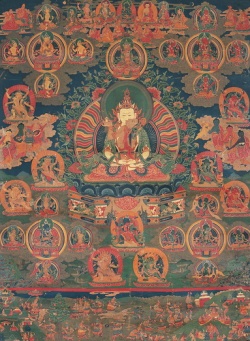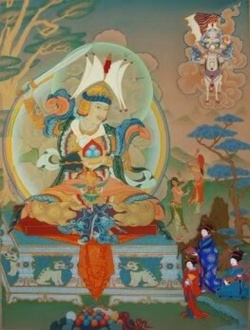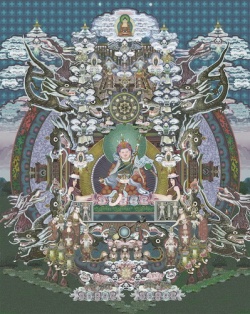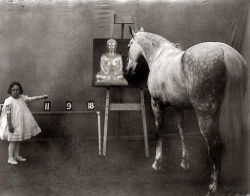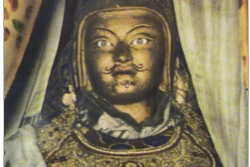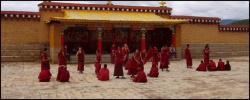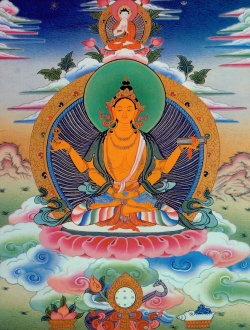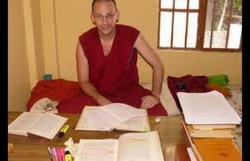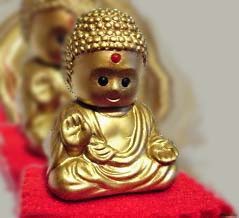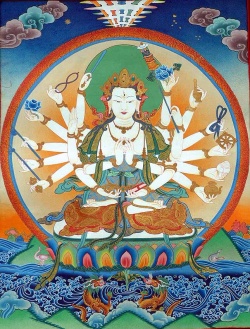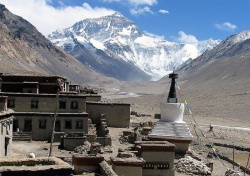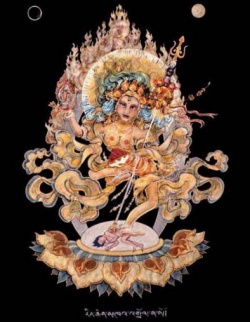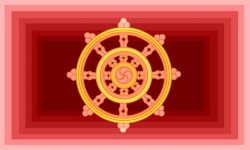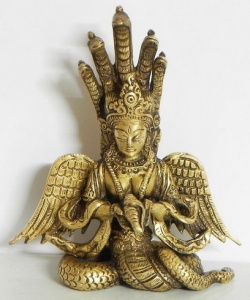Bardo
Click here to see other articles relating to word Bardo
[[Image:Peaceful guhyagarbha.JPG|thumb|250px|Peaceful Deities from the Mandala of Hundred Peaceful and Wrathful Deities)]
Bardo (Tib. བར་དོ་, Wyl. bar do; Skt. antarābhava) — commonly used to denote the intermediate state between death and rebirth, but in reality bardos are occurring continuously, throughout both life and death, and are junctures at which the possibility of liberation, or enlightenment, is heightened.
bardo (chūin 中陰)
The state of existence between death and rebirth. Literally, that which is "in between" (chū 中) and "hidden" or "vague" (in 陰). In the Buddhist tradition there is a widespread belief that the deceased will be in the bardo state for a maximum of seven weeks, or forty-nine days in all. At the end of each week, if the spirit of the deceased has not entered a new womb, it "dies" again and starts the process of locating a womb over again.
Literal Meaning
Sogyal Rinpoche writes:
- Bardo is a Tibetan word that simply means a “transition” or a gap between the completion of one situation and the onset of another. Bar means “in between,” and do means “suspended” or “thrown.”
Divisions
The different bardos can be categorized into four or six:
The Four Bardos
- the natural bardo of this life (Skt. jatyantarābhava; Tib. རང་བཞིན་སྐྱེ་བའི་བར་དོ་; Wyl. rang bzhin skye ba'i bar do) which begins when a connection with a new birth is first made and continues until the conditions that will certainly lead to death become manifest.
- the painful bardo of dying (Skt. mumūrṣāntarābhava; Tib. འཆི་ཁ་གནད་གཅོད་ཀྱི་བར་དོ་; Wyl. 'chi kha gnad gcod kyi bar do) which begins when these conditions manifest and continues until the 'inner respiration' ceases and the luminosity of the dharmakaya dawns.
- the luminous bardo of dharmata (Skt. dharmatāntarābhava; Tib. ཆོས་ཉིད་འོད་གསལ་གྱི་བར་དོ་; Wyl. chos nyid 'od gsal gyi bar do) which lasts from the moment the dharmakaya luminosity dawns after death and continues until the visions of precious spontaneous perfection are complete.
- the karmic bardo of becoming (Skt. bhāvāntarābhava; Tib. སྲིད་པ་ལས་ཀྱི་བར་དོ་; Wyl. srid pa las kyi bar do) which lasts from the moment the bardo body is created and continues until the connection with a new rebirth is made.
The Six Bardos
The four above with the addition of:
- 5. the bardo of meditation (Skt. samādhyantarābhava; Tib. བསམ་གཏན་གྱི་བར་དོ་, Wyl. bsam gtan gyi bar do)
- 6. the bardo of dreaming (Skt. svapanāntarābhava; Tib. རྨི་ལམ་གྱི་བར་དོ་, Wyl. rmi lam gyi bar do)
These two bardos are part of the natural bardo of this life.
Literature
Dzogchen Tantras
- Union of the Sun and Moon (Tib. ཉི་ཟླ་ཁ་སྦྱོར་, Wyl. nyi zla kha sbyor)
- Self-arising Primordial Awareness (Tib. རིག་པ་རང་ཤར་, Wyl. rig pa rang shar)
Termas
- Karma Lingpa, The Peaceful and Wrathful Deities, The Profound Dharma of Self-liberated Wisdom Mind (Tib. Zabchö Shitro Gongpa Rangdrol; Wyl. zab chos zhi khro dgongs pa rang grol), which contains the Great Liberation through Hearing in the Bardo (Tib. Bardo Tödrol Chenmo; Wyl. bar do thos grol chen mo)
Instruction Manuals
Commentaries
- Tsele Natsok Rangdrol, བར་དོ་སྤྱིའི་དོན་ཐམས་ཅད་གསལ་བར་བྱེད་པ་དྲན་པའི་མེ་ལོང་, bar do spyi'i don thams cad gsal bar byed pa dran pa'i me long
Alternative Translations of the Term 'Bardo'
- transitional process (Wallace)
Further Reading
- Chögyam Trungpa, Transcending Madness: The Experience of the Six Bardos, The Collected Works of Chögyam Trungpa, Volume Six.
- Chökyi Nyima Rinpoche, The Bardo Guidebook, Rangjung Yeshe Publications, 1991
- Dudjom Rinpoche, 'An Introduction to the Bardo' in Counsels from My Heart, Shambhala 2001, pages 59-75
- Dzogchen Ponlop, Mind Beyond Death (Ithaca: Snow Lion Publications, 2006)
- His Holiness Dilgo Khyentse Rinpoche, Pure Appearance—Development and Completion Stages in the Vajrayana Practice (Halifax: Vajravairochana Translation Committee, 2002), Ch. 2 & 3. (restricted publication)
- Padmasambhava, Natural Liberation—Padmasambhava’s Teachings on the Six Bardos, commentary by Gyatrul Rinpoche, translated by Allan Wallace (Boston: Wisdom Publications, 1998, 2008)
- Sogyal Rinpoche, The Tibetan Book of Living and Dying, revised and updated edition, Harper San Francisco, 2002.
- Tsele Natsok Rangdrol, Mirror of Mindfulness: The Cycle of the Four Bardos, translated by Erik Pema Kunsang (Boston & Shaftesbury: Shambhala, 1989).
- Tulku Thondup, Enlightened Journey—Buddhist Practice as Daily Life, edited by Harold Talbott (Boston: Shambhala Publications, 1995), Ch.6 'Preparing for the Bardo'.
- Tulku Thondup, Peaceful Death, Joyful Rebirth (Boston & London: Shambhala, 2005) ISBN 1-59030-182-X
- Tulku Urgyen Rinpoche, Rainbow Painting: A Collection of Miscellaneous Aspects of Development and Completion (North Atlantic Books, 2004), 'Bardo' chapter.
- See the Tibetan Book of the Dead article for English translations & further reading
See Also
External Links
Source
Bardo (bar do, antarabhava). 'Intermediate state.' Usually refers to the period between death and the next rebirth. For details of the four bardos, see Mirror of Mindfulness and Bardo Guidebook.
The Tibetan word bardo means literally "intermediate state" - also translated as "transitional state" or "in-between state" or "liminal state". In Sanskrit the concept has the name antarabhāva.
It is a concept which arose soon after the Buddha's passing, with a number of earlier Buddhist groups accepting the existence of such an intermediate state, while other schools rejected it.
Used loosely, the term "bardo" refers to the state of existence intermediate between two lives on earth. According to Tibetan tradition, after death and before one's next birth, when one's consciousness is not connected with a physical body, one experiences a variety of phenomena.
These usually follow a particular sequence of degeneration from, just after death, the clearest experiences of reality of which one is spiritually capable, and then proceeding to terrifying hallucinations that arise from the impulses of one's previous unskillful actions.
For the prepared and appropriately trained individuals the bardo offers a state of great opportunity for liberation, since transcendental insight may arise with the direct experience of reality, while for others it can become a place of danger as the karmically created hallucinations can impel one into a less than desirable rebirth.
The term bardo can also be used metaphorically to describe times when our usual way of life becomes suspended, as, for example, during a period of illness or during a meditation retreat.
Such times can prove fruitful for spiritual progress because external constraints diminish. However, they can also present challenges because our less skillful impulses may come to the foreground, just as in the sidpa bardo.
Intermediate state in Indian Buddhism
From the records of early Buddhist schools, it appears that at least six different groups accepted the notion of an intermediate existence (antarābhava), namely, the Sarvāstivāda, Darṣṭāntika, Vātsīputrīyas, Saṃmitīya, Pūrvaśaila and late Mahīśāsaka. The first four of these are closely related schools. Opposing them were the Mahāsaṃghika, early Mahīśāsaka, Theravāda, Vibhajyavāda and the Śāriputra Abhidharma (possibly Dharmagupta) (Bareau 1955: 291).
Some of the earliest references we have to the “intermediate existence” are to be found in the Sarvāstivādin text the Mahāvibhāṣa 阿毘達磨大毘婆沙論. For instance, the Mahāvibhāṣa indicates a “basic existence” (本有), an “intermediate existence” (中有), a “birth existence” (生有) and “death existence” (死有) (CBETA, T27, no. 1545, p. 959, etc.). Bareau (1955: 143) provides the arguments of the Sarvāstivāda as follows:
The intermediate being who makes the passage in this way from one existence to the next is formed, like every living being, of the five aggregates (skandha).
His existence is demonstrated by the fact that it cannot have any discontinuity in time and space between the place and moment of death and those of rebirth, and therefore it must be that the two existences belonging to the same series are linked in time and space by an intermediate stage.
The intermediate being is the Gandharva, the presence of which is as necessary at conception as the fecundity and union of the parents.
Furthermore, the Antarāparinirvāyin is an Anāgamin who obtains parinirvāṇa during the intermediary existence.
As for the heinous criminal guilty of one of the five crimes without interval (ānantarya), he passes in quite the same way by an intermediate existence at the end of which he is reborn necessarily in hell.
Deriving from a later period of the same school, though with some differences, Vasubandhu’s Abhidharmakośa explains (English trs. p. 383ff):
What is an intermediate being, and an intermediate existence? Intermediate existence, which inserts itself between existence at death and existence at birth, not having arrived at the location where it should go, cannot be said to be born.
Between death-that is, the five skandhas of the moment of death – and arising – that is, the five skandhas of the moment of rebirth-there is found an existence-a "body" of five skandhas-that goes to the place of rebirth. This existence between two realms of rebirth (gatī) is called intermediate existence.
He cites a number of texts and examples to defend the notion against other schools which reject it and claim that death in one life is immediately followed by rebirth in the next, without any intermediate state in between the two.
Both the Mahāvibhāṣa and the Abhidharmakośa have the notion of the intermediate state lasting "seven times seven days" (i.e. 49 days) at most. This is one view, though, and there were also others.
Similar arguments were also used in Harivarman’s *Satyasiddhi Śāstra, a quasi-Mahāyāna text, and the Upadeśa commentary on the Prajñāpāramitā Sūtras, both of which have strong influence from the Sarvāstivāda school. Both of these texts had powerful influence in Chinese Buddhism, which also accepts this idea as a rule.
The Saddharma-smṛty-upasthāna Sūtra (正法念處經) classifies 17 intermediate states with different experiences.
Six bardos in Tibetan Buddhism
Fremantle (2001) states that there are six traditional bardo states known as the Six Bardos:
the Bardo of This Life (p. 55);
the Bardo of Meditation (p. 58);
the Bardo of Dream (p. 62);
the Bardo of Dying (p. 64);
the Bardo of Dharmata (p. 65); and
the Bardo of Existence (p. 66).
Shugchang, et al. (2000: p.
5) discuss the Zhitro (Tibetan: Zhi-khro) teachings which subsume the Bardo Thodol and mention Karma Lingpa, terma and Padmasambhava and list the Six Bardo:
"The first bardo begins when we take birth and endures as long as we live.
The second is the bardo of dreams.
The third is the bardo of concentration or meditation.
The fourth occurs at the moment of death.
The fifth is known as the bardo of the luminosity of the true nature.
The sixth is called the bardo of transmigration or karmic becoming.
Shinay bardo (Tibetan): is the first bardo of birth and life. This bardo commences from conception until the last breath, when the mindstream withdraws from the body.
Milam bardo (Tibetan): is the second bardo of the dream state. The Milam Bardo is a subset of the first Bardo. Dream Yoga develops practices to integrate the dream state into Buddhist sadhana.
Samten bardo (Tibetan) is the third bardo of meditation.
This bardo is generally only experienced by meditators, though individuals may have spontaneous experience of it. Samten Bardo is a subset of the Shinay Bardo.
Chikkhai bardo (Tibetan): is the fourth bardo of the moment of death. According to tradition, this bardo is held to commence when the outer and inner signs presage that the onset of death is nigh, and continues through the dissolution or transmutation of the Mahabhuta until the external and internal breath has completed.
Chönyid bardo (Tibetan): is the fifth bardo of the luminosity of the true nature which commences after the final 'inner breath' (Sanskrit: prana, vayu; Tibetan: rlung).
It is within this Bardo that visions and auditory phenomena occur. In the Dzogchen teachings, these are known as the spontaneously manifesting Thödgal (Tibetan:
thod-rgyal) visions.
Concomitant to these visions, there is a welling of profound peace and pristine awareness.
Sentient beings who have not practiced during their lived experience and/or who do not recognize the clear light (Tibetan: od gsal) at the moment of death are usually deluded throughout the fifth bardo of luminosity.
Sidpa bardo (Tibetan): is the sixth bardo of becoming or transmigration. This bardo endures until the inner-breath commences in the new transmigrating form determined by the 'karmic seeds' within the storehouse consciousness.
Exegesis
Fremantle (2001: p. 53-54) charts the development of the bardo concept through the Himalayan tradition:
Originally bardo referred only to the period between one life and the next, and this is still its normal meaning when it is mentioned without any qualification.
There was considerable dispute over this theory during the early centuries of Buddhism, with one side arguing that rebirth (or conception) follows immediately after death, and the other saying that there must be an interval between the two.
With the rise of mahayana, belief in a transitional period prevailed.
Later Buddhism expanded the whole concept to distinguish six or more similar states, covering the whole cycle of life, death, and rebirth.
But it can also be interpreted as any transitional experience, any state that lies between two other states.
Its original meaning, the experience of being between death and rebirth, is the prototype of the bardo experience, while the six traditional bardos show how the essential qualities of that experience are also present in other transitional periods.
By refining even further the understanding of the essence of bardo, it can then be applied to every moment of existence. The present moment, the now, is a continual bardo, always suspended between the past and the future.
However, as shown above, Fremantle's idea that it was originally only "between one life and next" was not how it was used by the Sarvāstivāda school from the outset.
Also, the idea that the ascendancy of this idea was due to the Mahāyāna is unfounded, and it is much more likely that it was due to the Sarvāstivāda influence, several centuries before the Mahāyāna had any real influence.
